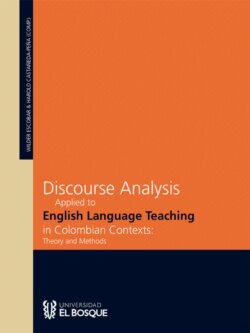Читать книгу Discourse analysis applied to english language teaching in colombian contexts: theory and methods - Wilder Yesid Escobar Alméciga - Страница 9
На сайте Литреса книга снята с продажи.
Introduction
ОглавлениеDiscourse analysis in linguistics has been applied to work on the way sentences or utterances cohere into discourse (Potter, 2004) and linguists have also developed the work of discourse analysis through the use of classroom interaction. This rather restricted view of the possible scopes of the linguistic studies of discourse is challenged by Van Dijk (1981), who argued years earlier, that by “discourse studies we refer to the new interdisciplinary field between linguistics, poetics, psychology and the social sciences concerned with the systematic theory and analysis of discourses and their various contexts” (Van Dijk, 1981, p. 1). Among those various contexts, it seems that the educational context has been ranked as one important valuable object of study.
There is truth in both Potter’s and Van Dijk’s views, but their somewhat dissimilar positions about the range of action that discourse analysis has might indicate more than a lack of coherence within what is traditionally understood by discourse analysis. Consequently, a complete deconstruction of discourse analysis applied to classroom language with the philosophical approach Derrida recommends may still be needed. This entails a search for the limits and margins of discourse analysis (Derrida, 1982) if research of this type is to qualify its own scope and methods.
This deconstructive claim is especially understood if we keep in mind the overwhelming expansion of research that started especially in the late 60’s and early 70’s about specific educational contexts where classroom language is analyzed (Bellack et al., 1966; Cazden et al., 1972; Sinclair and Coulthard, 1975; Cazden, 1988) and is still growing to date (Christie, 2002). Discourse analysis studies have involved the second and foreign language classrooms (McCarthy and Carter, 1994; Seedhouse, 1995; Nunn, 2001) and (MacNaughton, 1988; Blackbourn-Brockman, 2001). For a recent review regarding Latin America, see Castañeda-Peña (2012).
It is within such heterogeneous approaches that this chapter aims at briefly sketching the discourse analysis applied to classroom language. In order to achieve this goal, how discourse studies have viewed classroom language will be described; second, discourse analysis in general educational settings and the feminist post-structuralist approach will be outlined; third, discourse analysis in foreign and second language educational settings will be traced; fourth, the discussion about which methodology is appropriate to investigate classroom discourse will be summarized. Finally, I will introduce my own discussion about researching classroom discourse in foreign/second language instructional settings. The review proposed is not exhaustive but comprehensive in scope.
